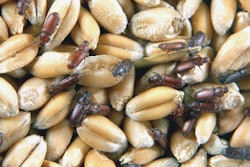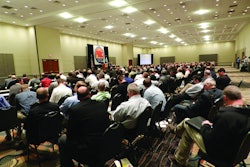A common, but often under-utilized tool, near infrared spectroscopy (NIR) determines the nutrient profile of feed ingredients. NIR provides a fast, repeatable means of measuring protein, fat, fiber, moisture, ash content and even amino acid profile of feed ingredients, in less than one minute. It is generally used as a tool for making claims against a supplier for low protein content, or for flagging suppliers delivering high moisture ingredients. Often though, only a few samples are measured for each delivery of a feed ingredient, resulting in measurements that are not used to modify feed formulations, or as input to least cost formulation systems used by nutritionists. The measurement of one or two samples simply is not representative of the full delivery.
NIR now has the necessary speed of analysis to measure a statistically significant number of samples from each load of feed, or feed ingredient, as it is unloaded. This will allow nutritionists to accurately determine the average value and standard deviation of nutrient profiles using a statistically significant number of samples, enabling tighter formulation control and lower nutrient giveaway.
Sample collection is the first hurdle; collecting larger numbers of samples prior to unloading increases the retention time for trucks and railcars. The best solution is to collect samples while the truck or railcar is being unloaded. This can be accomplished using an automated sampling auger.
The larger number of samples received at the lab is the second issue. Twenty samples from a single load of corn could be collected in five minutes, but it would require 20 minutes to analyze the samples. Obviously, a large backlog quickly develops. One answer lies in decoupling the sample handling from the sample measurement. NIR systems now allow fast loading of feed ingredient samples and feature internal storage of up to 250 samples. Processing takes about three hours, allowing the lab personnel to collect additional samples or to perform other duties while the measurement is performed. The results are tabulated in a database accessible to the nutritionists for determination of running averages and standard deviations for each of the feed ingredients.
Auto-sampling systems, while superior to single sample analysis, still pose limitations on the sampling frequency that can be maintained in a feed mill. It is simply not possible to attain the sampling frequency of an in-line measurement system when using laboratory measurement systems — be it an auto sampler or multiple instruments measuring single samples.
As animal nutritional requirements are refined, and feed ingredient costs rise, it will become necessary for feed mills to enhance their ability to employ least-cost-formulation methods to maintain profitable operations. High-frequency NIR sampling is an avenue for providing timely, accurate profiling of feed ingredient nutritional content necessary to meet formulation requirements while controlling ingredient costs.
Dean E. Robertsis the business manager for the agriculture, food and feed market segments for Bruker Optics North America. Roberts received a Bachelor of Science in chemistry from the University of Wisconsin – Madison. As business manager for AFF, Dean applies his 30 plus years’ experience in analytical chemistry to help develop new methods and processes to measure the quality and safety of food and feed ingredients, and assess the impact of ingredient variation on final product quality. He can be reached at[email protected].





















